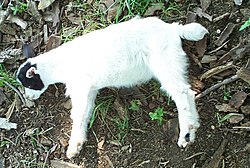Fainting goat
This article needs additional citations for verification. (May 2009) |

A myotonic goat, otherwise known as the fainting goat, is a domestic goat that freezes for roughly 3 seconds when it feels panic. Though painless, this generally results in the animal collapsing on its side. The characteristic is caused by a hereditary genetic disorder called myotonia congenita. When startled, younger goats will stiffen and fall over. Older goats learn to spread their legs or lean against something when startled, and often they continue to run about in an awkward, stiff-legged shuffle.
Characteristics
Slightly smaller than standard breeds of the goat, fainting goats are generally 43 to 64 cm (17 to 25 in) tall and can weigh anywhere from 27 to 79 kg (60 to 174 lb). Males, or billies, as they are often referred to, can be as heavy as 90 kilograms (200 lb).[1] They have large, prominent eyes in high sockets. Their hair can be short or long, with certain individuals producing a great deal of cashmere during colder months. There appears to be no angora strain of the fainting goat. Common coat colors are black and white; however, most possible coat colors are found in this breed.
Fainting goats have many other names, including myotonic goats, Tennessee (meat) goats, nervous goats, stiff-leg goats, wooden-leg goats, and Tennessee fainting goats.[1] They are smaller and somewhat easier to care for and maintain than larger meat goat breeds, which makes the fainting goat desirable for smaller farms. They are also raised as pet or show animals as they can be friendly, intelligent, easy to keep, and amusing.
Fainting goats have a muscle condition called myotonia congenita. This is a condition which occurs in many species, including humans. The goats do not truly "faint" in any sense of the word, as they never lose consciousness because of their myotonia.[2]
Classified as a meat goat as opposed to a dairy goat, it can be raised for chevon (goat meat). This breed is listed as threatened by The Livestock Conservancy, so the fainting goat is not used as often for chevon as other meat goat breeds; its rarity makes the live goat more valuable.[3] The fainting goat is specialized for smaller production operations as they are unable to challenge fences as vigorously as larger meat goat breeds. This is due in part to their smaller size and also because of the myotonia. Their size makes them easier to care for during chores such as foot trimming and administering medication. Smaller specimens of fainting goats are frequently kept as pets.
Besides the myotonia, another distinguishing feature of the fainting goat is its prominently set eyes. The eyes protrude from the eye sockets, as opposed to recessed eyes seen in other breeds. The profile is straight as opposed to the convex or "roman" profile.
Cause of fainting
This condition is caused by an inherited disorder of a chloride channel in the muscles of the skeleton (skeletal muscle chloride channel 1, CLCN1).[4] The responsible gene is autosomal dominant, but has incomplete penetrance, leading to variable severity of the condition.[5] In affected goats, the CLCN1 gene contains a missense mutation; the amino acid alanine is replaced with a proline residue. This small change causes the choride channel in the muscle fibres to have a reduced conductance of chloride ions.[6] This causes a delay in the relaxation of the muscles after the goat has made a voluntary movement.[4] This results in a painless cramping of the muscles.[7]
History
Fainting goats were first brought to Marshall County, Tennessee in the 1880s.[8] By the 1980s, few of the goats remained.[8]
The fainting was first described in scientific literature in 1904, and described as a "congenital myotonia" in 1939.[9] The mutation in the goat gene which causes this muscle stiffness was discovered in 1996, several years after the equivalent gene had been discovered in humans and mice.[9]
Society and culture
- The Goats, Music and More Festival celebrates the fainting goat. It is held annually in October, in Marshall County, Tennessee.[8]
- The existence of the fainting goat was investigated on the U.S. television show MythBusters.[10]
References
- ^ a b "Myotonic Goat Description". Retrieved 2005-01-01.
- ^ ""Why Fainting Goats Do What They Do", D. Phillip Sponenberg". Retrieved 2004-03-01.
- ^ "American Livestock Breeds Conservancy Watchlist". 2007-12-12. Retrieved 2006-07-11.
- ^ a b Constable, PD; Hinchcliff, KW; Done, SH; Gruenberg, W. "Inherited diseases of muscle". Veterinary Medicine - A textbook of the diseases of cattle, horses, sheep, pigs and goats (11th ed.). Elsevier. pp. 1514–30. ISBN 9780702052460.
- ^ Smith, BP, ed. (2015). "Chapter 42: Diseases of muscle. Myotonia". Large animal internal medicine (5th ed.). Mosby. p. 1281. ISBN 978-0-323-08839-8.
- ^ Lorenz, Michael D.; Coates, Joan R.; Kent, Marc (2011). Handbook of veterinary neurology (5th ed.). St. Louis, Missouri: Elsevier/Saunders. p. 310. ISBN 978-1-4377-0651-2.
- ^ Watras, JM (2017). "Chapter 12: Skeletal muscle physiology". In Koeppen, BM; Stanton, SA (eds.). Berne and Levy Physiology. Elsevier. p. 253. ISBN 978-0-323-39394-2.
- ^ a b c Kazek, K (2011). "The tale of the bulgy-eyed fainting goats". Forgotten tales of Tennessee. Charleston, SC: History Press. ISBN 9781625841483.
- ^ a b Rüdel, R (2000). "Muscle chloride channelopathies: myotonia congenita". In Lehmann-Horn, Frank; Jurkat-Rott, Karin (eds.). Channelopathies. Burlington: Elsevier. pp. 44–46. ISBN 9780080528854.
- ^ "Do Fainting Goats Really Exist?". Discovery. 11 April 2012. Retrieved 2017-08-20.
